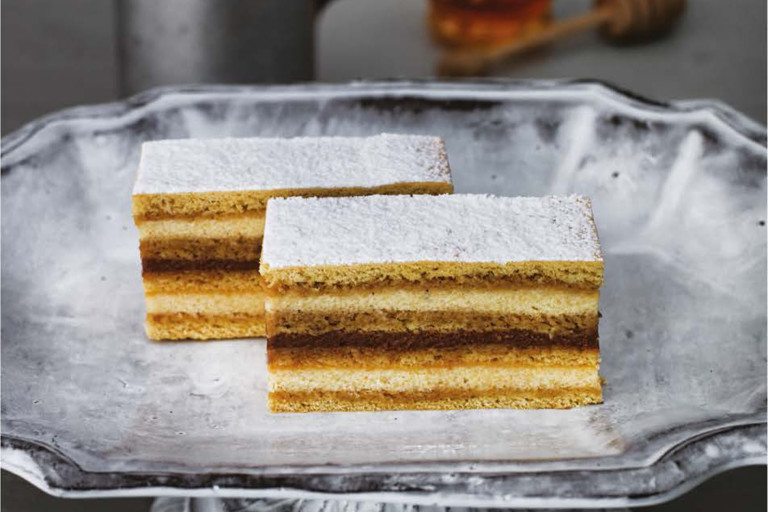Croatian honey cake
Item 1 of 1
Claire Clarke serves up a stunning Croatian honey cake recipe, with intricate layers of rum-soaked, honey-infused sponge and chocolate custard. A technical bake for those looking for a challenge. This recipe is taken from 80 Cakes From Around the World by Claire Clark, published by Absolute Press.
First published in 2018
This is one of the most popular desserts in Croatia and consists of honey sponge soaked with rum syrup and layered with honey and chocolate custard. I really like the way it looks when cut into oblongs.
Ingredients
Metric
Imperial
- 400g of plain flour
- 1 tbsp of bicarbonate of soda
- 45ml of whole milk
- 45ml of vegetable oil
- 30g of light runny honey
- 150g of caster sugar
- 1 medium egg, lightly beaten
- icing sugar
- 1 vanilla pod
- 500ml of whole milk
Honey and chocolate custard
- 75g of runny honey
- 75g of caster sugar
- 6 tbsp of fine semolina
- 200g of unsalted butter, diced
- 100g of dark chocolate, chopped
Rum syrup
- 100g of caster sugar
- 100ml of water
- 50ml of dark rum
SAVE RECIPE
Equipment
- Swiss roll tin 2
- Pastry brush
Method
1
Sift together the flour and bicarbonate of soda, then repeat twice. Put the milk, oil, honey and sugar in a pan and place over a low heat until the honey and sugar dissolve, stirring continuously. Remove from the heat and leave to cool until hand hot. Add the flour and egg, mix by hand until everything starts coming together, then knead gently into a soft dough. Wrap the dough in cling film and leave to rest in the fridge for 15 minutes
2
Take 2 Swiss roll tins, approximately 37cm x 28cm, and cut a piece of baking parchment to fit the base of each one. Cut the dough in half. Roll out one piece of dough on one piece of baking parchment, then carefully lift it, still on the paper, into a Swiss roll tin. Repeat with the second piece of dough
3
Preheat the oven to 180°C/gas mark 4
4
Bake both tins of dough in the centre of the oven for 5 minutes, until barely set. It should feel firm to the touch but still be pale. Take care not to over bake, or it will become fragile and crisp. Remove from the oven and immediately cut each sheet neatly in half across its width. Leave to cool in the trays
5
Meanwhile, make the custard. Slit the vanilla pod open lengthwise and put it in a small pan with the milk, honey and sugar. Bring to the boil and then remove from the heat. Whisk in the semolina and return to a low heat, whisking constantly until it thickens. Remove from the heat and take out the vanilla pod. Scrape the seeds from the pod into the mixture and whisk to combine
6
Transfer to a mixing bowl, cover the surface with cling film and leave to cool until it is hand hot. Whisk in the butter a little at a time, mixing well after each addition
7
Transfer to a clean bowl, cover the surface with cling film and leave to cool. Melt the chocolate in a microwave or in bowl set over a pan of gently simmering water, making sure the water does not touch the base of the bowl. Transfer a third of the filling to a separate bowl and stir in the chocolate. Keep both fillings covered
8
To make the syrup, bring the sugar and water to the boil in a small pan, stirring to dissolve the sugar. Remove from the heat and add the rum
9
To assemble the cake, place one piece on a square cake card and, using a pastry brush, soak it with about a quarter of the warm rum syrup. Spread half the honey custard evenly over the cake
10
Place another sponge layer on top and press down gently. Soak it with rum syrup, then spread the chocolate custard on top. Add a third layer of cake, press down gently and soak with more rum syrup
11
Spread the remaining honey custard over it, cover with the last layer of sponge and soak with the remaining syrup. (If you did over bake the base, put the cake in an airtight container and leave in the fridge overnight; it will soften considerably)
12
Trim the sides with a sharp knife, then cut the cake into 8 rectangles. Dust with a little icing sugar before serving
Get in touch
Please sign in or register to send a comment to Great British Chefs.


